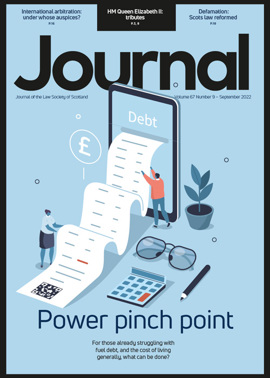Defamation in the modern age

Major changes occurred in Scotland’s law of defamation with the coming into force of many of the provisions of the Defamation and Malicious Publication (Scotland) Act 2021 on 8 August 2022.
The changes made by the Act are extensive. A full discussion of its impact and the previous law would require considerably more space than the present piece, but there are a number of major changes that legal practitioners may wish to bear in mind.
Changes to the actors in defamation
One significant change that the Act makes is to exclude certain public authorities from bringing defamation proceedings against people (s 2). This seems to be a statutory reflection of a longstanding policy of the law in England & Wales (Derbyshire County Council v Times Newspapers [1993] AC 534 (HL)). It appears never to have been definitively clarified whether this principle applied in Scotland, though it seemed likely that Scots courts would follow that approach.
The definition of public authorities in s 2 covers a core set of central government institutions, local authorities, and courts and tribunals. It does, however, also contain a more general definition relating to those exercising functions of a public nature (s 2(2)(d)), and it remains to be tested where the limits of this will lie. Universities, for instance, present an interesting example of a body whose status may be mixed or uncertain. Questions relating to individual officers (under s 2(5)) and elected representatives of public bodies would seem to fall outside the definition, allowing them to bring defamation actions, but this may provide grounds for further debate as well.
Changes to the concept of publication
The concept of publication and when an act of publication leads to liability has also been significantly altered by the Act. In the first instance, defamation now requires that a third party becomes aware of the statement, whereas this was not previously the case in Scots law (s 1(2)).
The Act also limits the ability to bring proceedings against those regarded as “secondary” publishers, by defining who is generally responsible for offending publications (s 3(1) and (2)). It also clarifies that certain acts, including hyperlinking, will not generally attract liability for defamation (s 3(3) and (4)). There is also some future-proofing in the Act by allowing for regulations to extend the types of acts that will be considered “secondary” forms of publication (s 3(6) and (7)).
Setting thresholds for defamation claims
One of the most significant changes in the Act, and perhaps the most contested, is the creation of a “serious harm to reputation” requirement. Section 1(2) requires that any defamatory statement cause, or be likely to cause, serious harm to reputation in order to be actionable. A similar requirement was inserted into English law and has been the subject of discussion up to and including at UK Supreme Court level (Lachaux v Independent Print Ltd [2019] UKSC 27). It will be interesting to see how the Scots courts interpret this requirement and how this serves as a practical or procedural point of initial dispute in defamation proceedings in Scotland. Section 1 also clarifies that, for trading entities, serious harm is equated with serious financial harm rather than any more intangible harm to reputation of the business.
Section 19 of the Act sets up a significant barrier to what has sometimes been called “libel tourism”, by imposing particular requirements in proceedings brought in the Scottish courts against persons domiciled outside the UK. This section requires a court to be satisfied that Scotland is “clearly the most appropriate place to bring proceedings in respect of the statement” (s 19(2)). How this works will have to be tested in practice, particularly as the section also preserves the doctrine of forum non conveniens (s 19(4)).
Section 32 also reduces the limitation period for defamation (and malicious publication) actions from three years to one year, amending s 18A of the Prescription and Limitation (Scotland) Act 1973. It also inserts new language to govern re-publication or subsequent, substantially similar publications of a statement and when they will or will not become actionable (s 32(3), inserting a new s 18A(1A) into the 1973 Act).
The nature of defamatory statements
Section 1 also codifies previous case law definitions of “defamatory” statements as generally being those that “[tend] to lower the person’s reputation in the estimation of ordinary persons” (s 1(4)). This is likely to be no great change in the law, but does provide a clear definition of what is in issue in defamation actions.
Changes to defences
The historical defences to a defamation action have undergone some reorganisation, and are now to be known as the defences of truth (s 5) and honest opinion (s 7). The truth defence also clarifies the degree to which the statement or statements complained of are required to be true, in order to address cases where there is some marginal variance between the truth and the exact nature and effect of the statements (s 5(2)).
The defence of statements in the public interest arose out of the House of Lords case of Reynolds v Times Newspapers [2001] 2 AC 127, and has been referred to by the Inner House on a few occasions (see, for instance Curran v Scottish Daily Record [2011] CSIH 86; 2012 SLT 359). Section 6 of the Act follows English statute law (s 4 of the Defamation Act 2013) in creating a new, statutory defence called publication on a matter of public interest. Clarifying the existence of such a defence and setting the criteria for its exercise is helpful, though the defence itself is likely to be highly fact dependent (as acknowledged in s 6(2)), and some benefit may still be found in referring to the prior law.
Changes to privileges
The Act also makes some changes to the defences of absolute and qualified privilege. First, the contemporaneous reporting of court proceedings is definitively placed within the category of absolute privilege (by s 9 of the Act).
The changes to qualified privilege are slightly more complex. It is worth noting that the Act explicitly does not seek to codify an exhaustive list of occasions on which qualified privilege will apply, and there is still scope for innovation within the common law in this area (s 11(7)(b)). It does, however, provide an entire schedule of situations in which qualified privilege will apply as well as the conditions under which these types of qualified privilege may be exercised (s 11(2) to (6)). There is also an explicit qualified privilege for statements in scientific and academic publications (s 10).
Offers of amends
Sections 13 to 17 of the Act provide new options in respect of the resolution of and remedies for defamation actions. This is principally by allowing defenders to make offers of amends to pursuers comprising corrections, apologies and damages or other steps as necessary (s 13). Such offers must be made before defences are lodged (s 13(2)(a)), creating both a drive to resolve cases but also likely additional urgency in the initial stages of a defamation action.
The Act then defines the conditions for acceptance and enforcement of offers to make amends, including enforcement by a court (s 14). It is worth noting that there are particular provisions dealing with offers of amends which are only partially agreed (e.g. the parties disagree as to damages or expenses – s 14(4)-(7)), and where offers are qualified (i.e. restricted to certain meanings – s 14(9)). The Act also dictates the consequences where both unqualified and qualified offers are rejected (ss 16 and 17). It will be interesting to see how these sections are relied on in practice and the effect which offers, even qualified ones, have on awards of damages and/or expenses.
Procedure
The Act also makes some procedural tweaks, such as removing any presumption that defamation actions are to be tried by jury (s 20).
There is also power for the court to make an order for the publication of a summary of its judgment where it finds for the pursuer in a defamation matter (s 28). The parties have the first go at agreeing this (under s 28(2)), but if not, the court will have to determine what is to be published and how (s 28(3)). There are also powers applying to open statements settling cases, and the removal of defamatory statements (ss 29 and 30).
Law of malicious publication
Lastly, as the name of the Act suggests, it also reforms the law relating to harmful statements other than those which are defamatory. It does this by abolishing the law of verbal injury and substantially defining the elements of the action for malicious publication (ss 21-27). This is a helpful reform of a messy area of the law. Whether this new clarity leads to a greater use of this delict remains to be seen.
Conclusion
The Act, though fairly short (with 40 sections and one schedule), represents a very substantial reform of numerous, important parts of the law of defamation and malicious publication. There is certainly more that could be said about its various provisions. The coming years will no doubt involve questions as to the application of its provisions, and likely litigation clarifying how it is to work in practice.
Regulars
Perspectives
Features
Briefings
- Civil court: Pointers to the future
- Intellectual property: Data mining for all
- Agriculture: The next land reform package
- Corporate: Developments and divergence in data
- Sport: Lessons from the Whyte review
- Scottish Solicitors' Discipline Tribunal
- Property: Registration – over a decade?
- In-house: The top team – three more years







